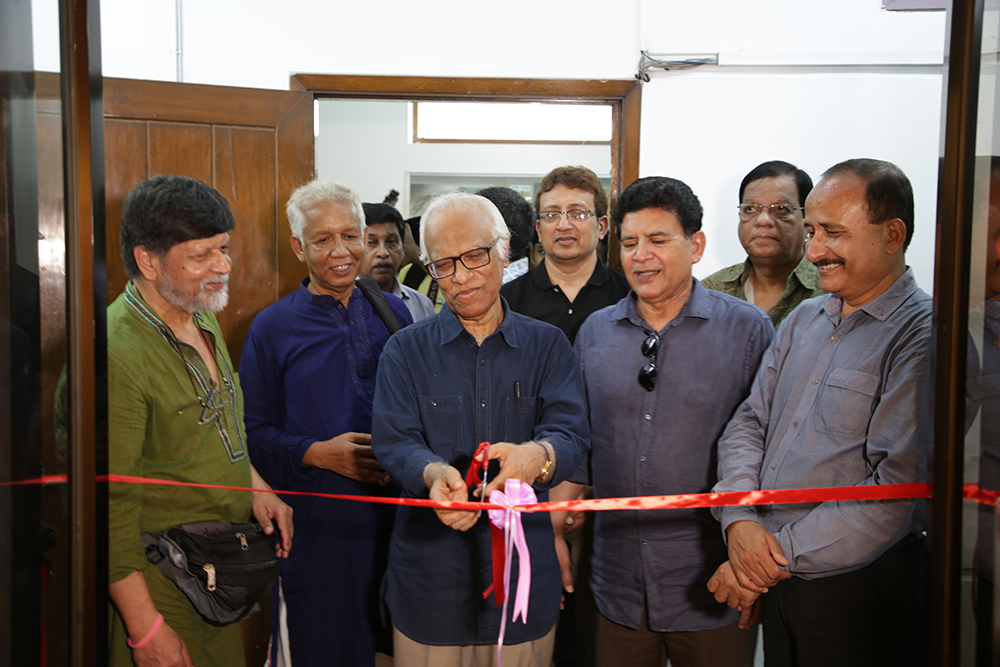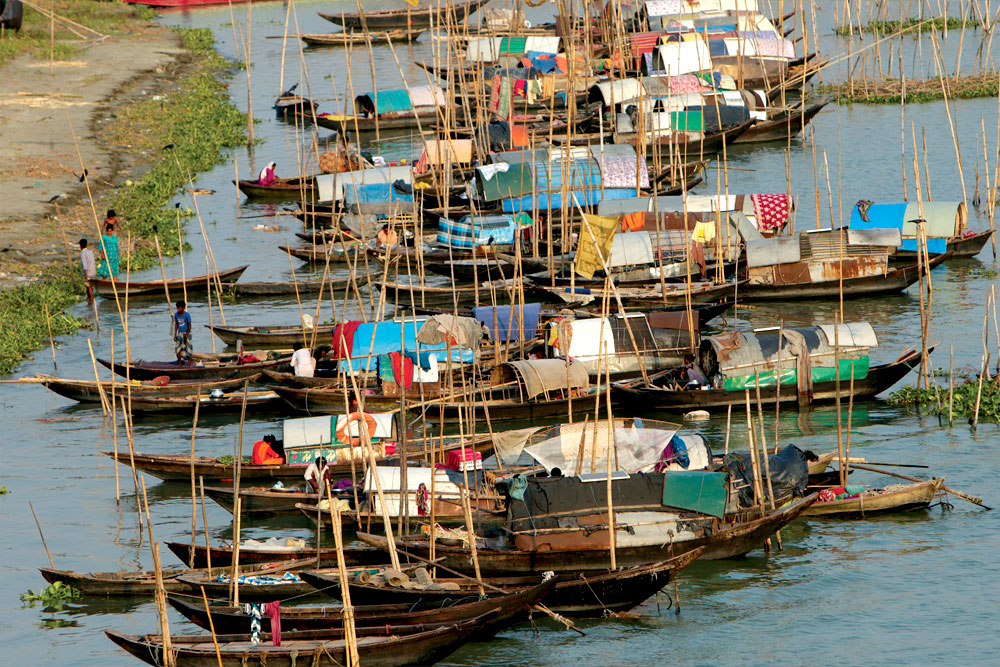
Photography Exhibition: BRATTYAJAN
A photography exhibition, BRATTYAJAN (The Lower Depths) by Philip Gain was organized from 19 to 25 June 2019 at DRIK Gallery, Dhanmondi, Dhaka. The exhibition brought to light the ethnic and tea communities, Bede, sex workers, Kaiputra, Rishi, Harijan, Jaladas and Bihari. They constitute most of the social outcasts and excluded people of Bangladesh. Around 200 images showing the identities, lives and struggles of these communities were on display at the exhibition.
Social Outcasts, Excluded and Marginalized Communities
Prof. Wahiduddin Mahmud is inaugurating the photoraphy exhibition. He is surrounded by (from left) Dr. Shahidul Alam, Moazzem Hossain, Prof. Adnan Zillur Morshed, Dr. Hossain Zillur Rahman, Dr. Harishankar Jaladas and Philip Gain.
There are groups of people and communities that have become victims of discrimination, exploitation and exclusion for generations or for hundreds of years and in some cases for a thousand years. They are spread around the world including Bangladesh. The factors that underlie include the beliefs and disbeliefs in fictional realities (religions), ethnic identities, slavery, occupations, casteism, culture, migration, hatred and geographical locations among others. The people, too weak, marginalized and broken can be called BRATTYAJAN. In Maxim Gorky’s play, The Lower Depths, they are social outcasts and in Hindu casteism or Varna they belong to even below the Shudra or in the fifth Varna. Their capability deprivation is deep-rooted and it is possibly the biggest modern-day challenge for Bangladesh, South Asia and many other countries in the world.
Four organizations implementing the project organized the photography exhibition, BRATTYAJAN (The Lower Depths) by Philip Gain from 19 to 25 June 2019 at DRIK Gallery, Dhanmondi, Dhaka.
The exhibition brought to light the ethnic and tea communities, Bede, sex workers, Kaiputra, Rishi, Harijan, Jaladas and Bihari. They constitute most of the social outcasts and excluded people of Bangladesh. Around 200 images showing the identities, lives and struggles of these communities were on display at the exhibition.
The opening of the photography exhibition was held on 19 June 2019. The participants in the opening session—as many as 150—represented ethnic and marginal communities, anthropologists, architect, film makers, researchers, writers and journalists. Two cultural teams—Garo and Santal, dressed in their traditional outfits danced, sang and beat their drums to welcome the guests. The sound of the drums and their traditional instruments gave a festive look to the opening session. Professor Wahiduddin Mahmud with other dignitaries opened the exhibition.
A panel of experts spoke at the opening session. They shed light on exclusion challenges and the difficulties these communities face in treading the path of development as equal citizens of Bangladesh.
Professor Wahiduddin Mahmud, the chief guest at the opening session, reflected on the condition of the marginal and excluded communities in Bangladesh. “It is very unfortunate that the marginal and excluded communities are undercounted and unnoticed in the government planning, statistics and national census,” remarked Prof. Mahmud. “In the government planning, their rights and social protection are not adequately addressed. Now its time to engage them and ensure equality for all.”
“The main objective of recent economic policy in Bangladesh is that there would be no destitute (Brattyajan) in the country by 2030. The Brattyajan constitutes three to four per cent of the total population. Is it possible to reduce poverty if this number remains unnoticed?” questioned Prof. Mahmud. His reflection was critical in his discussion on environmental pollution as a result of industrialization, urbanization and lucrative development projects. “Saving environmental balance is one of the key objectives of Sustainable Development Goals (SDGs). The life of the ethnic and marginal communities is largely dependent on the environment and forests. It is not possible to achieve SDGs without improving their lives,” warned Dr. Mahmud.
In his introductory remarks, Philip Gain, the photographer of the exhibition and director of SEHD was critical in his reflection on the forest land and its people in Modhupur. “We have displayed images of 115 communities in the exhibition. Among these, 25 exclusive pictures on Modhupur show how monoculture and other factors have changed the landscape and environment of a unique forest that survived thousands of years,” said Gain. “I have travelled quite extensively through the Modhupur forest villages since 1987 and have taken tens of thousands of photos of the devastation of the Modhupur sal forest due to rubber monoculture, social forestry with invasive species and commercial banana, pineapple and spice plantations.”
In reference to a recent household survey of 44 forest villages in Modhupur, Gain informed that 61.11% of the inhabitants in these villages are Bangalees, 33.47% are Garos and 5.42% are Koch. Only 13% of the Bangalee households have title deeds (CS and RoR) for their homestead land, which is only 4.19% for the Garos. For high land where they grow banana, pineapple, spice

and other garden crops only 4.83% Bangalee households and 2.61% Garo households have CS or ROR for their land. For the low land 9.67% Bangalee households and 11.17% Garos households have CS and RoR.
On his experience in work with the tea communities, Gain informed, “We have found 80 communities in the tea gardens. Information about these communities can be found in our book, Slaves in These Times. In the northwest, we have also found 37 ethnic communities, majority of them were not on the government list until recently. Images on all these communities are part of this exhibition.”
The chair of the launch, Dr. Hossain Zillur Rahman, executive chairman of Power and Participation Research Centre (PPRC) and former advisor to the caretaker government, reminded in his remarks, “Documentation is unavoidable to scale up visibility of the marginal communities, who remain out of sight. The lead photographer of the exhibition, Philip Gain has been working restlessly to bring the excluded and marginal people to light. It is now important for all of us to work together to make them visible.” Dr. Rahman stressed on the inclusion of these communities in the eighth five-year plan of the government.
Others who spoke at the launching were Dr. Shahidul Alam, an internationally renowned photographer; Masihuddin Saker, architect and filmmaker; Professor Adnan Zillur Morshed, executive director, Centre for Inclusive Architect and Urbanism, BRAC University; Dr Harishankar Jaladas, writer and novelist; Chitta Ghosh, senior journalist, Bede leader Soud Khan and Moazzem Hossain, chief executive of Gram Bikash Kendra (GBK).

